Introduction of a cross-border contact and opportunity management system at Insightful AG
The CRM case of Insightful AG is a representative example of the efforts by Swiss SMEs to embrace the area of Customer Relationship Management (CRM) in the international arena. Insightful AG epitomises the concept of developing a European hub out of a US-based company (HQ) - the perfect task to prove that CRM really can bring benefits. Insightful AG was born of the merger of 4 independent companies which were already operating at a regional level. Each of these partners had at least one address system. The new sales concept created initially for the whole Europe and Middle East area (EMEA) was taken as the basis for the CRM system. Due to the high degree of decentralisation of operating sales units and the central management and marketing in Switzerland a CRM system had to be developed as both a link and a management system. The knowledge gained in the realisation of this project demonstrates that even complex CRM requirements need not always be complicated and carry a heavy financial burden.
Inhaltsverzeichnis
1. The companySWOT analysis
2. Devising strategy: "The Way to the Decision"
Goals, Marketing cycle, Sales channels, Sales concept, Requirements, Potential benefits, Costs, Return on Investment, Market activity concept
3. Implementation, "The Way to Tapping Potential"
Functions, Database, Marketing, Opportunity management
4. CRM solution: "Operation"
Project phases, Information management
5. Salient points: "Success factors"
1. The company
Background to the company:
Insightful AG is a leading company in the area of development, sales and implementation of statistical and analytical software. The company’s great success in the U.S. was the result of products which were both well developed technologically and reasonably priced, combined with competent consultation and professional project organisation. Sales activity in the European market was conducted initially via partners with external sales forces and office staff. Sales cycles in this project business varies from 1 to 12 months. Therefore it is extremely important for the company that the resources available operate in the market as efficiently and effectively as possible. That is why a tightly managed EMEA organisation had to be built up in order to cope with European growth.
Market and industry sector:
Insightful AG sells technologically superior analytical software for almost all industry sectors, from financial service providers, to sales firms, through to pharmaceutical companies and health services. Salient features of this market are very extensive projects and purely box-move business when it comes to procuring off-the-peg solutions for specified tasks (text mining, etc.). As a result, both long and short cycles of decision-taking and procurement can be expected in this business area and/or market. Market zoning (USP) is in fact only possible in the areas of service provision and solution pricing. Crowding out is rife in the market and there is great need to protect investments (key player vs. start-ups), which again has to do primarily with trust. In principle, then, it represents an "ideal" environment for CRM.
The market suffers on the one hand from a high level of specialisation; as a result, it is difficult to sell these products without consultation and engineering. On the other hand, companies, above all large ones, know exactly what they want and thus determine the price-performance ratio. Price sensitivity and above all price transparency have been raised through the introduction of the euro.
Other trends are:
- The trend towards direct sales (internet downloads) of simple products; complex products remain consultation-intensive
- The trend towards solutions which depart from "semi-fabricated" or frameworks
- The trend towards outsourcing of services and thus other business models
Products:
The products marketed by Insightful AG are "languages", frameworks or "semi-fabrications" for certain tasks and industry sectors, as well as comprehensive system solutions requiring a high level of competence on the part of the provider on the ground and a good service network.
Reasons for the decision to implement CRM:
Insightful AG is conscious of its need for comprehensive information about the market and its players. Against this background a decision was taken over a year ago to acquire a cross-border contact and opportunity management system. After detailed inspection of the applications (SalesLogix, Wincard, etc.) already in place in the local countries, the decision was taken in favour of a new installation with professional assistance (consultation). To understand the reason for the CRM decision and above all its motivation, it is necessary to consider briefly the company’s SWOT analysis.
Strengths
- Expertise, service quality, availability of specialists
- High penetration in universities and other seats of higher learning
- High level of acceptance and high profile in the U.S.
Weaknesses
- Scant structures, above all in the case of the low-cost market (box-move)
- Many offers lack qualification
- Lack of consistency in reworking offers (conversion rate)
- Sales funnel not transparent, not "filled" in a structured way
- Channelling of marketing investment into lead process is insufficient
- Patchy market coverage (isolated campaigns)
Opportunities
- Profile can be raised through good, up-to-date product information in the internet
- Market share can be gained through technological consultation, new areas of functionality/application (demand creation)
- Excellent price-performance ratio
- Cross-selling possible via product lines
Threats
- Several dominant market leaders are established
- Very broad application area (industry sectors, markets, etc.)
2. Devising strategy: "The Way to the Decision"
CRM vision:
"With the aid of business competence and state-of-the-art analysis technologies, Insightful creates added value for its customers in the area of gathering, processing and distributing information. The highest priority is a focused orientation on industry sector and technology. Quality, specialist expertise and determined customer orientation are both fundamental factors in our success and the main challenge to our partners. In this way we strive to assure that our offering is at all times trustworthy and credible and to harness comprehensive customer knowledge in the long term."
CRM goals:
Successful CRM is heavily influenced by measurable goals. One vision regulates fundamental behaviour and aids correct allocation of steps taken. CRM projects should not, however, serve to justify failure, but increase added value and enable the company’s lasting growth. That is why great emphasis was placed at Insightful AG on the following goals, broad outlines of which are listed below:
- Get to know potential customers and their needs
- Be aware of “buying centres” (relationship in the companies and across the board)
- Identify windows of opportunities and actively take advantage of them
- Recognise trends in the market, evaluate them and react in good time
- Clear communication and positioning across the whole European market
- Build trust through professional relationship management: management of contacts and leads
- Communicative perception support (as perceived by customers)
- Use references as multipliers
- Make expertise and experience available via various media for use within the sales organisation
- Broad overview of customers for improved customer retention
Insightful AG aims to use the available opportunities in a more targeted and comprehensive way in order to increase the proportion of loyal regular customers who can be quoted as references. This is significantly dependent upon placing at the disposal of every single regionally organised sales representative an instrument which provides them with optimum assistance in serving and acquiring potential customers and customers. Central availability of information must likewise be ensured, as indeed must local coordination of centrally led marketing and sales campaigns.
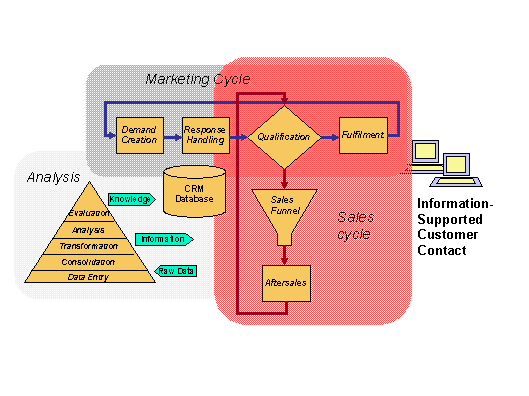
Figure 1: marketing cycle
Organisation:
Insightful AG operates with four international branch offices whose main task lies in working the market and in distribution. Dispatch and logistics are handled centrally from the U.K. while marketing and management are based in Switzerland. The complexity of such a task requires active support by means of an efficient and effective opportunities and contacts management system.
Sales structure, "Box": Below are the main sales channels through which the "Box" product line should be distributed. Out of these channels leads should also be generated for project business:
| channel |
Description/notes
|
| Telesales | Specific products should be offered and sold on the telephone using the mail-call-mail method. Distribution is online or by Postexpress (via download from fixed-location partners). First-level support (expert-to-expert) is also run with the same organisation. |
| Web | Offers are made and customers are won by means of banner links and e-mail push technology (permission marketing). Sales via credit card or customer no. (identification) or on receipt of invoice (processing by telesales). Distribution is online or by Postexpress (via download from fixed-location partners). |
| Distributors | Wherever there is as yet no market activity (new countries) distributors should take on the task of developing the market according to the situation. Sales processing through distributors’ catalogues, websites or as (commission paid) link to Insightful web sales/telesales (straight-through processing). Distribution online or by Postexpress from distributor. |
| Resellers (VARs), possibly VADs | Wherever a distributor is deployed, the service should be handled by the same distributor, otherwise equal conditions, but service by telesales. The precondition is a niche market (little support workload/expenditure involved). |
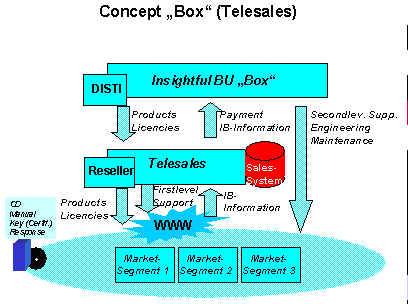
Figure 2: sales concept
Requirements of the tool:
On the basis of the assessment (national requirements of local countries) and of the consultation carried out, a rough requirements catalogue was drawn up, which the following requirements were defined, regardless of whether or in what form such solutions already existed:
| Requirement |
Area
|
| Customer data |
|
| Project data |
|
| Rapport data | Rapports of all kinds, e.g.:
|
| Opportunity management |
|
| Bidding |
|
| Sales management |
|
| Marketing management |
|
| Knowledge database |
|
Potential benefits:
The following table shows the high level to which an integrated CRM system fulfils expectations. It is not a question of absolute values, but of the percentage contribution of the CRM system to overall success; i.e. a kind of “effectiveness level” for the CRM.
|
Area of benefit
|
Opportunities/potential
|
Implementation level with CRM
|
| Leverage Marketing |
|
70 % |
| Focus |
|
80% |
| Product lifecycle |
|
80% |
| Raise market share |
|
Cannot be quantified |
| Customer retention |
|
Cannot be quantified |
Costs:
After a potential analysis conducted as a preparatory phase, the general project was sub-divided into two "digestible" steps. The first step entailed contact management, opportunity management and marketing and market management in Switzerland (pilot). There were no plans for an interface with the enterprise resource planning system. A subsequent induction phase lasting roughly three months was set aside to direct the necessary second step (international roll-out) in the light of first experiences, that is to say, allow for the development process of the sales organisation (consolidation of countries and their processes) and utilisation of the system. The cost of the entire project (consultation, planning, licences, customising, installation, training) over approximately 12 months amounts to just under CHF 250,000 (not including annual running and maintenance costs). This sum was quoted as a fixed-price project.
Return on Investment of CRM solution:
No figures from the previous year were available to calculate ROI because implementation of the "country systems" varied. The following quantifiable and non-quantifiable benefits of CRM are expected in the following areas:
Marketing
- Transparency of marketing activities in the market
- Integration of nationally planned marketing into international sales processes
- Targeted opportunity management (better conversion rate)
- Highly qualified leads and prospects
Focusing resources
- Effective "funnel management" (resources optimisation)
- Automation of contact and activities management
- Strategic account evaluation and management
Market penetration
- Customer retention, i.e. increased turnover in regular customer segment through better control of product lifecycle
- Partner integration and management
Raise market share
- Individualised standard offers (mass customisation)
- Redesign of sales concept and tight control of process
- Closeness to customer and swift reaction
Customer retention
- Integration of the internet (community)
- E-mail services
- Training and further education schemes
Potential increases of between 20% and over 40% are expected after this CRM solution has been introduced across all areas in years 1-3. That means an ROI period of <1 Jahr following introduction of the full version. This ambitious objective is attainable, as shown by the values after more than six months.
Relationships with business partners:
By integrating partners in all market and marketing activities, it is possible to react in a more flexible and cost-effective way to products and service requirements, etc. In addition, quality with regard to both workflow and information flow is dramatically improved, since there are far fewer media gaps. It also transpired that handling key figures and warning systems in the context of cause and effect chains significantly improved forecasting.
Relationships with customers:
All relevant sales processes which took place in the course of the project were recorded and evaluated. This work was carried out with the aid of workshops (experience) and orientation to "standards" with regard to CRM applications (functions, workflows, etc.). Fine-tuning was carried out chiefly in the area of automation in favour of possible CRM systems, where these did not undermine personal relationships to customers.
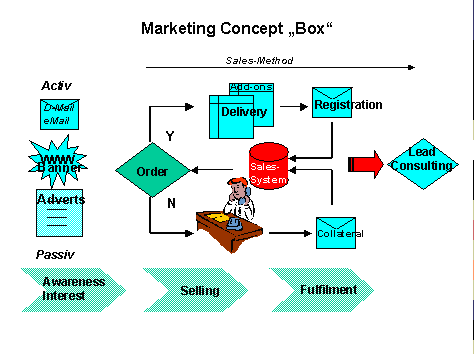
Fig. 3: Market activity concept
3. Implementation, "The Way to Tapping Potential"
Relationship to “complementaries”:
Due to the market activity strategy implemented by Insightful AG, added value in the area of "complementaries" is chiefly orientated towards the partner companies which create market-compatible solutions from Insightful AG products. Although these partner companies are still unable to access the CRM system there are plans to integrate them by developing a “partner hub” (via the web).
Relationship within the company:
The original tendency to rely on "lucky punches" has been removed by targeted market activity. Today a clearly improved grasp of customers, projects opportunities/threats and above all greatly improved reporting prevail both within the EMEA area and for the parent company in the U.S.
3. Implementation; "The way to tapping potential"
Functional requirements:
The key requirements have been described in the following chapter. The goal, i.e. the requirements of the target (CRM) system, is integration of both partners and customers based on a CRM system tailored to Insightful AG.
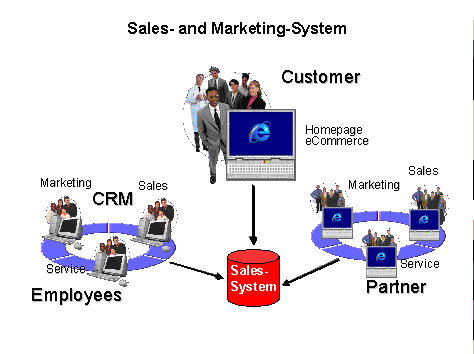
Fig. 4: Target CRM system
Details of all functions were set down in a process-orientated "story book" where changes were recorded on an on-going basis and incorporated in the planning of further development steps.
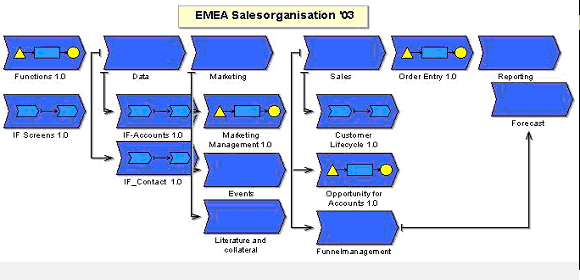
Fig. 5: Diagram of CRM functions
The CRM database forms the basis for the future "information system" and manages information about customers and prospects with the corresponding contact person, their function, roles and entire history. In addition to the correct address (multimedia) and classifications of segmentation (ABC, area, etc.), structured information should be gathered regarding the corresponding characteristics (need, potential, professional and private interests) as well as the contact activities in the market, those already carried out and those planned (mailings, visits, telephone calls, e-mails, etc). Data regarding potential, forecasts, bidding (configuration) and status of sales projects should be related to contact activity in the market so that an overall evaluation (current and historic) can be conducted in each company with regard to contact frequency, progress and success.
Marketing:
Selections from the CRM database must be drawn up according to widely varying (multi-level) criteria for the purpose of executing marketing campaigns in several languages. The selections should be automatically linked to activities (standard letters, e-mails, telephones, etc.) and dates (schedulers). Response results should be categorised accordingly and lead into the next campaign level (campaign loop) for fulfilment and follow-up.
The literature fulfilment is likewise managed by the system, whether in the form of electronically available products or paper flyers and brochures. Depending on campaign set-up, this task is completed either locally or centrally. Marketing management likewise manages the countries’ budgets and reporting and/or allocation.
Sales:
All instances of contact (activities such as phone calls, visits, letters, etc.) to customers and prospects on all levels (external sales force, office-based staff, marketing, management and service) should be recorded and planned in the contact and activities manager. Follow-up activities and deadlines should also be available to various users (lead tracking) and should provide the basis for sales controlling (performance management). Through the automation of reporting and correspondence, the sales organisation should be relieved of routine administration tasks.
Opportunity management:
External sales representatives should be able to systematically find out at any time the best opportunities on the market. In this regard information is heavily weighted towards the respective product lifecycle (lifecycles of products and contracts). Furthermore, the external sales force should analyse the customer relationship to the respective prospects and customers in order to be able to decide on how to proceed tactically. Opportunities can be "hung onto" international projects and thus synchronised. Any bid and variants resulting from this are transferred to the funnel management and monitored.
Funnel management:
For the purposes of planning and steering sales, instances involved and resources, the Sales Funnel Manager has a multi-level sales level plan with flexible reporting facilities which are also used as the basis for awarding commissions to individual external sales representatives. Planning and steering are carried out with the aid of key figures.
Order entry:
When offers/opportunities become orders and projects these are first entered into the CRM system and transmitted to the ERP with the aid of standard reports. For reasons of complexity, this process is still executed manually in the current phase. The progress of such orders can only be tracked using the CRM system.
4. CRM solution: "Operation"
Organisational prerequisites:
The introduction of an integrated CRM system does not require a concentrated approach. Thus in the project phase a project team should be formed and a steering committee set up to monitor the work of the project team and scrutinise all decisions.
The following project approach proved effective:
- A thorough situation analysis is conducted to ascertain effective need
- All requirements are laid down in performance specifications and/or story book
- Possible standard solutions and their flexibility are evaluated
- Pilot systems are installed
- Pilot systems are tested with the aid of "model cases" (scripts are written)
- Organisational modifications are carried out
- Diverse parts of the marketing database, user interfaces and processes are introduced
- Workshops and user groups are set up for the purpose of further refining the database
- All marketing and sales concepts are transferred to the new system
- The marketing database, the necessary processes and data are updated
Two staff jobs have been allowed for, besides those who are pure users (internal or outsourced):
- Data input of mass data: This job entails entry of all mass data and response data which cannot be accepted automatically.
- System administrator: This job entails assurance of smooth technical functionality of the system and user support -> Helpline.
Information management:
Quality is everything. Insight AG has set itself several standards with regard to quality and consistency of data and information in its CRM system. Thus the sales department is remunerated not only on the basis of turnover/sales volume but are also rewarded for the quality of its CRM work and its documentation. Monitoring the relevant standards and decisive fine-tuning by means of external sources is Information Management, which is made up of members of company and sales management.
|
Level
|
Company | Contact | Project |
|
1
|
|
|
|
|
2
|
|
|
|
|
3
|
|
|
|
|
4
|
|
|
Figure 6: Levels of information management
System structure:
The evaluated system had to support and/or integrate the following technologies:
- MS Windows and browser as user front-end
- SQL database
- ODBC interfaces for integration
- Efficient replicating mechanisms (LAN/WAN, integration, remote users, etc.)
- MS/Outlook integration
Insightful opted for the CRM system from PIVOTAL, because it met all requirements best and above all possessed the necessary flexibility with regard to modifications and protection of investment.
The application is run on a standard NT system connected to the LAN. Internal users communicate with the server by means of clients. "Externals", that is, external sales representatives, use the remote client either from wherever they are on the road or from home; the remote client only mutates changed data only and thus does not place a high time load on the communication link.
5. Salient points: "Success factors"
Decisive changes:
In the opinion of Insight AG, what proved decisive for the success of this project was the decision not to orientate efforts towards a product or a solution, but to the relevant benefit - this was determined with the assistance of an experienced consultancy in a very short time. Only when the requirements and the room for manoeuvre were clear did the company undertake the search for the relevant solution. During this undertaking it was established that there are numerous applications which meet the relevant requirements and that as a result the company could concentrate on selection criteria such as training, support, spread, etc.
Internal handling of such a system can be seen as a significant change: previously, contacts and documents were "administered". Today, the system has become a working tool which is “finding its place” more and more. That means that certain jobs and/or functions which were considered to be "time- or labour-intensive" until a few weeks ago have become second nature, such as filling a car with petrol before departing on a trip. Utilisation of the system is thus evolving almost of its own accord.
After negative experiences on other IT projects (deadlines and budgeted cost exceeded, failure to meet expectations, shortcomings in implementation quality, orientation towards problems instead of solutions, overselling by providers), Insightful AG executed the CRM project via the general contractor (consultancy company) and not via the technology provider. This decisive orientation towards the target business model prevented technologies becoming bogged down in functions and gadgetry which were relevant neither to the goal nor the task at hand. Permanent endorsement of relevance by the consultant in every detail enabled this project to be realised within the set budgets of cost and time (fixed price, fixed time).
General effects:
A CRM system must be introduced professionally and with a certain dexterity in order to be able to reap maximum benefit from it. The balance between "give and take" must be both assured and transparent. Thus the quality of data and information cannot be achieved and maintained exclusively with the aid of "guidelines and rules". Relevant, lacking data must be arrived at or procured within the context of the overall strategy and placed at the disposal of the external sales force as extra service and support with correct management of master data.
That means that a CRM project must be aligned in an interdisciplinary way and be brought to a common goal. In this regard, internal information policy in the form of a project marketing campaign play a significant role because CRM can only be effective if the company structure is aligned with the project for the purpose of customer orientation.
Lessons learned:
Diverse tasks and effects only manifest themselves in the course of a project. Therefore, in the opinion of Insightful AG, the success of a CRM project hinges on experienced partners and suppliers at the company’s side who are able to relate to areas such as data quality, processes, management structures and decision-making principles.
The project should be sub-divided into digestible steps. Technology and technical skill are rather insignificant success factor. Sales concepts, their processes and above all the goals must be clearly and comprehensibly formulated.
A certain time pressure helps, as does orientation towards clear budget specifications. Structured working with the aid of a story book assists precise exectuion of the business case and its communication even before the first template has been written. This procedure often is experienced as difficult, as very often the ability to visualise the application and its handling is lacking.




